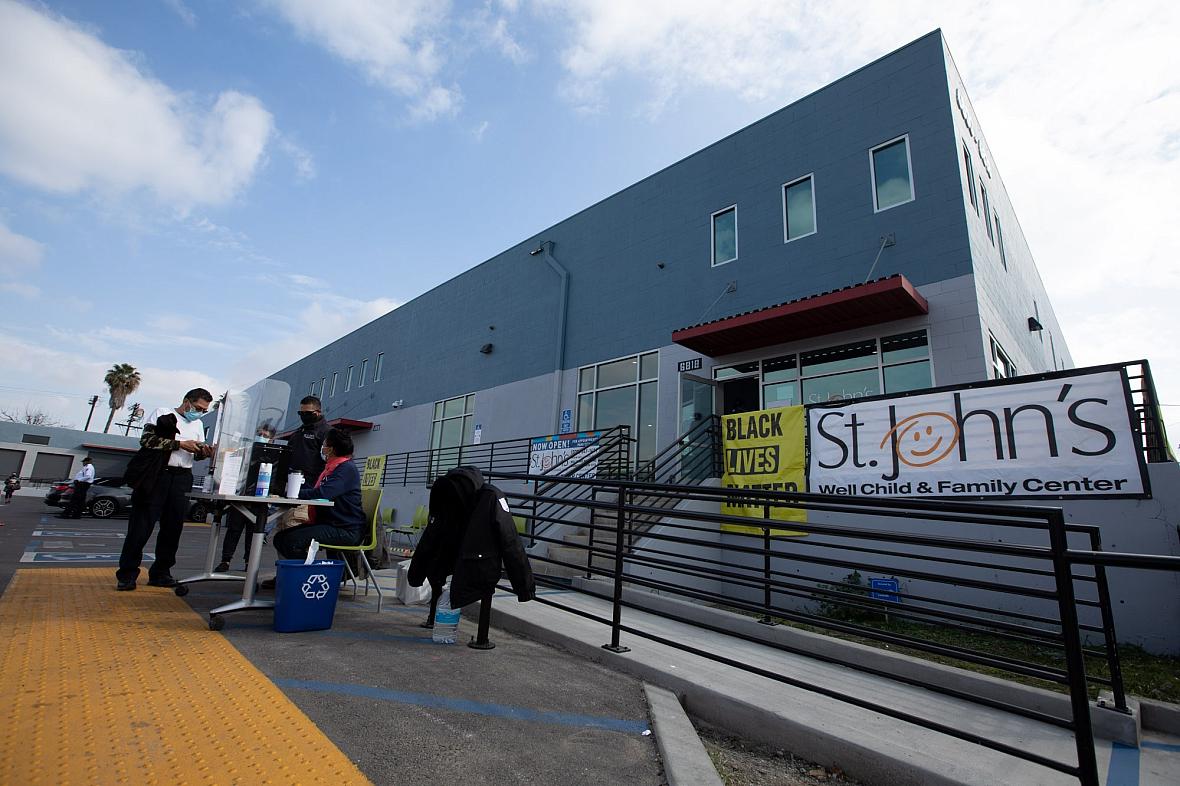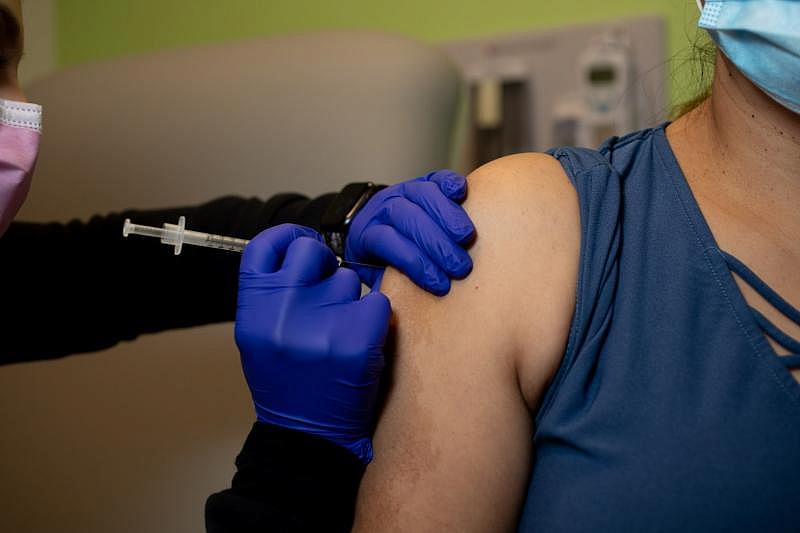California left clinics off vaccine list, so low-income patients are underserved
This project was led by Caitlin Antonios, a recipient of a 2021 Impact Fund grant from the USC Annenberg Center for Health Journalism.
Her other stories include:
How growers had to sidestep county and state programs to vaccinate farmworkers
A dozen counties criticized OptumServe for vaccine clinic problems, documents show

Patients arrive at the St. John's Well Child And Family Center to get inoculated with the Pfizer COVID-19 vaccine in South Los Angeles on Feb. 09, 2021.
Photo by Shae Hammond for CalMatters
Last fall, St. John’s Well Child and Family Center began purchasing sub-zero freezers to store the COVID-19 vaccine. By Nov. 20, St. John’s had eight freezers, with three more on the way.
The clinic’s CEO, Jim Mangia, reached out to Los Angeles County health officials to let them know they were ready to distribute the vaccine. “St. John’s stands ready as a resource to immunize thousands of people a week,” he wrote.
But California’s community health clinics had not been invited by the state to enroll as vaccine providers yet, even though the first doses were expected to arrive in Los Angeles in less than a month.
Mangia was incredulous. As a nonprofit health network with 19 clinics in South Los Angeles, Compton and Lynwood, St. John’s serves more than 100,000 patients each year, many of whom live in poverty or are undocumented immigrants.
“This is alarming, since community health centers (and primary care doctors) are on the frontline in any immunization efforts…so if we were excluded, I’m not sure how California will have a successful vaccine administration plan,” Mangia wrote back to county officials.
“It seems crucial that we address this disparity in Los Angeles County as quickly as possible.”
While hospitals received the first invitations to enroll as vaccine providers in October, community health centers — which serve almost one in five Californians, many low-income and disproportionately Latino — weren’t invited.
“Community health centers are on the frontline in any immunization efforts… so if we were excluded, I’m not sure how California will have a successful vaccine administration plan.”
JIM MANGIA, CEO OF ST. JOHN’S WELL CHILD AND FAMILY CENTER
Dr. M. Claire Jarashow, head of the Los Angeles County Department of Health’s vaccine program, told the clinic in an email that “subsequent invitations should be going out soon to partners such as yourself.” Jarashow added that the clinic was a “key partner” that served an important population that will “likely be early in the prioritization scheme.”
After the email exchange, county officials moved quickly to enroll his clinic. St. John’s received vaccine shipments by Christmas, Mangia said.
The weeks-long delay and mixed messaging for community health clinics were revealed in emails obtained through open-records requests by Columbia University’s Brown Institute for Media Innovation’s Documenting COVID-19 project in collaboration with CalMatters.
Last week, the California Primary Care Association, which represents community health centers, sent a sharply-worded, five-page letter to Gov. Gavin Newsom’s office, asking that community clinics be prioritized and included in administering the vaccine.
“We are in underserved communities. We are in communities that are most disadvantaged by this pandemic,” said Andie Martinez Patterson, the primary care association’s vice president of government affairs.
More than half of the 7.4 million patients seen at California’s community health centers each year are Latino, and 16% are Asian, Pacific Islander or Black patients, according to the California Primary Care Association. Clinics also serve a larger share of those enrolled in Medi-Cal, as well as California’s 860,000 agricultural workers and more than 360,000 homeless people.
“The first vaccines went to the hospitals, as they should have,” Mangia told CalMatters. “But then, if you think about the long-term vaccination effort, the vaccinations are not going to occur in the hospitals… That’s not what hospitals do, that’s what primary care and community health centers do.”
In response to the outcry from community health centers, California plans to release additional details of its new Vaccine Provider Network this week. The new system is expected to include public health systems, pharmacies, health systems, public hospitals, community health centers, pharmacies and pop-up and mobile sites.
“The transition to the new Vaccine Provider Network will ask each part of the healthcare ecosystem to do what it does best,” Darrel Ng, a spokesman for the state’s COVID-19 Task Force, said in response to questions. “For community clinics, we expect many of them and other community based organizations will be valuable partners in vaccinating many hard to reach communities.”
On Tuesday, the Biden administration announced that in an effort to reach disadvantaged communities, one million doses of vaccines will be shipped directly to federally qualified community health centers starting next week.
“We gotta help everybody”
California’s often-chaotic vaccine rollout has been plagued by multiple shortcomings including federal supply shortages, shifting vaccine eligibility guidelines for residents and widespread issues with pharmacies delivering doses to long-term care facilities.
Even with a recent uptick in daily doses — from 50,000 shots per day in early January to 150,000 at the end of the month — California ranks in the bottom half of states in the percentage of residents vaccinated, according to the Centers for Disease Control and Prevention (CDC).
Some of the issues center on California’s decision to enroll hospitals, but not clinics, as vaccine administration sites, due to an early focus on vaccinating frontline health care workers.
The state’s vaccine enrollment page says initial enrollment is limited to sites selected by local health departments. Other “interested providers (including clinics and pharmacies) will be welcome to enroll by early 2021.”
Martha Ortiz was inoculated with the Pfizer COVID-19 vaccine at St. John’s Well Child And Family Center in South Los Angeles on Feb. 09, 2021. Photo by Shae Hammond for CalMatters
Clínica Romero, which has two clinics serving patients in the Los Angeles neighborhoods of Boyle Heights and MacArthur Park, was notified in December that vaccines were coming. Then, after weeks of delay, the clinic was told they would not be receiving doses because there was a supply shortage.
It wasn’t until the first week of February that Clinica Romero was finally able to begin vaccinating patients. The small number of doses they received — just 100 shots — meant they had to turn away seniors from the community who were not Clínica Romero patients.
“I was so sad to see them go,” said Carlos Vaquerano, the clinic’s executive director. “We cannot do that anymore, we gotta help everybody.”
Even when vaccine supply increases, health centers fear that the state will not contract with them if they can’t demonstrate a high volume of patients.
“Hard-to-reach populations are by definition not high volume,” said Louise McCarthy, president and CEO of the Community Clinic Association of Los Angeles County.
McCarthy said the state’s decision to determine vaccine eligibility by age is not an equitable approach, since homeless and low-income people are at high risk, too.
“It is galling that a 63-year-old person experiencing homelessness on Skid Row does not get a dose when an affluent 65-year-old from Brentwood does,” McCarthy said. “That’s not equity.”
Caitlin Antonios, a California-based freelancer who works with the Documenting COVID-19 project at Columbia University’s Brown Institute for Media Innovation, reported this story while participating in the USC Annenberg Center for Health Journalism‘s 2020 Data Fellowship.
[This story was originally published by Cal Matters.]
Did you like this story? Your support means a lot! Your tax-deductible donation will advance our mission of supporting journalism as a catalyst for change.

